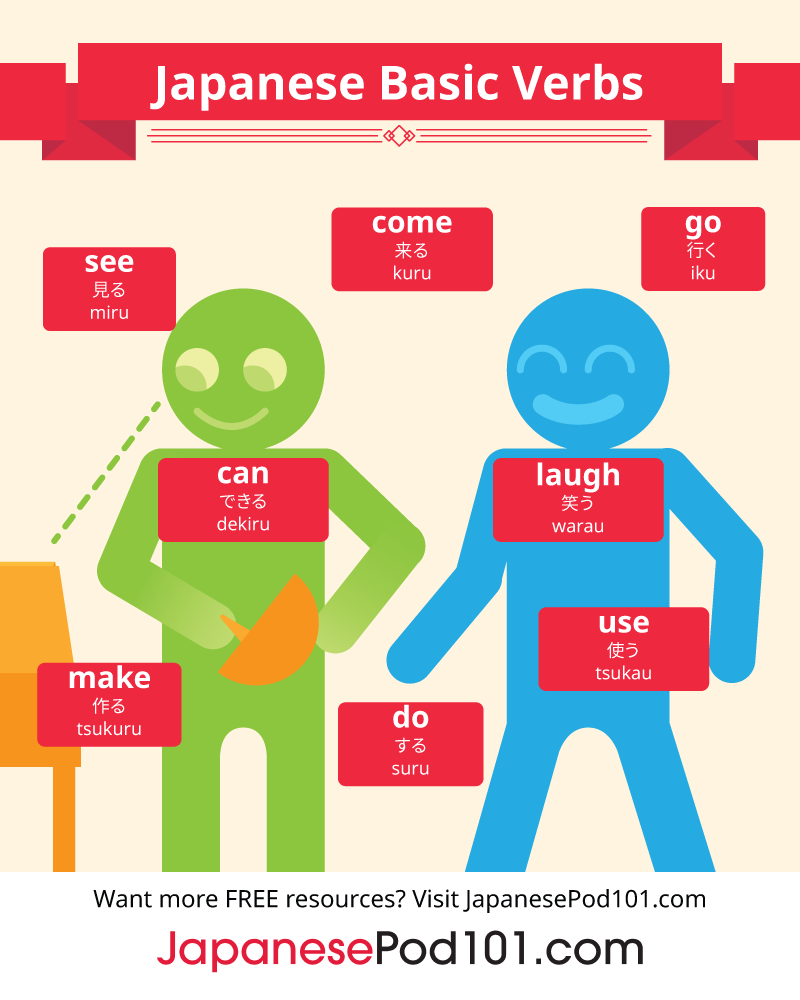
It’s impossible to explain something in detail without using adverbs. These are words which can efficiently express time, frequency, place, manner, degree, and more. When you want to boost your language skills, learning adverbs is important and inevitable.
Just like those in other languages, there are a variety of Japanese adverbs and they’re frequently used in sentences. Japanese adverbs are quite similar to English adverbs, though there are some differences to keep in mind. For example, Japanese adverbs are classified in categories according to their characteristics, and they’re placed in different positions in a sentence depending on how they’re used. But don’t worry! The rules are quite simple, and you’ll get the hang of them over time!
In this article, JapanesePod101.com will provide you with:
- A Japanese adverbs list containing 100 useful Japanese adverbs
- Explanations of how to use Japanese adverbs
- Examples of Japanese adverbs in sentences
Let’s get started!
 Table of Contents
Table of Contents
- The Adverb in Japanese: An Introduction
- Japanese Adverbs List
- How Do You Use Adverbs in Japanese Sentences?
- Conclusion: How JapanesePod101 Can Help You Learn More Japanese

When you learn Japanese adverbs, your conversation will be colorful and rich in expression.
1. The Adverb in Japanese: An Introduction
1 – What is the Function of Japanese Adverbs?
An adverb, or 副詞 (fukushi), is not an independent class of word, as it’s always used with other words. Adverbs are similar to adjectives in that they both modify words. However, adverbs modify verbs, or 動詞 (dōshi), adjectives, or 形容詞 (keiyōshi), and other adverbs, while adjectives only modify nouns, called 名詞 (meishi).
Japanese adverbs, unlike those in English, can appear anywhere in a sentence when they’re used before verbs.
2 – The Classifications and Types of Japanese Adverbs
1. Derived from Adjectives
Most adverbs are linked to adjectives that share similar meanings. By changing a part of an adjective, we can turn it into an adverb. You can also see this rule applied in English. For example: “first” / “kind” / “happy” (Adjectives) >>> “firstly” / “kindly” / “happily” (Adverbs).
In most cases, it’s easy to change Japanese adjectives to adverbs. There are two types of conjugations here.
- Modification of Japanese い (i) Adjectives
An い (i) adjective always ends with い (i).
By changing the final い (i) to く (ku), an adjective will turn into an adverb.
Example:
| い (i) Adjective [ Stem + い (i) ] | Adverb [ Stem + く(ku) ] |
| 悲しい kanashii “sad” | 悲しく kanashiku “sadly” |
| 高い takai “high” | 高く takaku “highly” |
| 丸い marui “round” | 丸く maruku “roundly” |
- Modification of Japanese な (na) Adjectives
A な (na) adjective always ends with な (na) when it comes before a noun.
Changing な (na) to に (ni) will convert a な (na) adjective into an adverb.
Example:
| Adjective [ Stem + な (na) ] | Adverb [ Stem + に (ni) ] |
| 親切な shinsetsu na “kind” | 親切に shinsetsu ni “kindly” |
| 静かな shizuka na “quiet” | 静かに shizuka ni “quietly” |
| 簡単な kantan na “easy” | 簡単に kantan ni “easily” |
For more information about Japanese adjectives, please visit 50 Most Common Adjectives.
- Other Non-Adjectival Adverbs
There are also Japanese adverbs which are not related to adjectives. Such adverbs do not have a particular pattern to identify them with, so you have to remember each vocabulary term. The good thing is that they’re used in the same way as other adverbs.
Non-adjectival adverbs are often seen among adverbs of frequency, time, and place, which we’ll explain in the following sections.
2. Classification of Japanese Adverbs
Japanese adverbs are classified into different categories, including Time, Frequency, Place, Manner, and Degree. Although it’s not so important to know which adverbs belong to what category, it is useful if you know them for more accurate usage.
Now let’s see various Japanese adverbs from each category!

Chirashizushi wa kantan ni tsukuremasu. = “You can make Chirashizushi easily.”
簡単に (Kantan ni) is an adverb.
2. Japanese Adverbs List
1 – Japanese Adverbs of Time
Japanese time adverbs indicate when something happens, has happened, or will happen.
| Meaning | Reading | Kanji | Hiragana | |
|---|---|---|---|---|
| 1 | “today” | kyō | 今日 | きょう |
| 2 | “yesterday” | kinō | 昨日 | きのう |
| 3 | “tomorrow” | ashita | 明日 | あした |
| 4 | “this morning” | kesa | 今朝 | けさ |
| 5 | “tonight” | kon’ya | 今夜 | こんや |
| 6 | “now” | ima | 今 | いま |
| 7 | “later” | ato de | 後で | あとで |
| 8 | “soon” | sugu ni | ー | すぐに |
| 9 | “right now” | ima sugu ni | 今すぐに | いますぐに |
| 10 | “previously” | mae ni | 前に | まえに |
| 11 | “recently” | saikin | 最近 | さいきん |
| 12 | “someday” | itsuka | ー | いつか |
| 13 | “yet” | mada | ー | まだ |
2 – Japanese Adverbs of Frequency
Adverbs of frequency are used when describing how often an action takes place.
| Meaning | Reading | Kanji | Hiragana | |
|---|---|---|---|---|
| 14 | “always” | itsumo | ー | いつも |
| 15 | “sometimes” | tokidoki | 時々 | ときどき |
| 16 | “often” | yoku | ー | よく |
| 17 | “rarely” | tama ni | ー | たまに |
| 18 | “seldom” | metta ni | ー | めったに *used only with negative forms |
| 19 | “probably” | tabun | 多分 | たぶん |
| 20 | “likely” | osoraku | ー | おそらく |
| 21 | “normally” | tsūjō | 通常 | つうじょう |
| 22 | “(not) at all” | zenzen (-nai) * | 全然 (ーない) * | ぜんぜん(ーない) * |
| 23 | “never” | kesshite (-nai) * | 決して (ーない) * | けっして(ーない) * |
| 24 | “definitely,” “inevitably” | kanarazu | 必ず | かならず |
| 25 | “daily,” “every day” | mainichi | 毎日 | まいにち |
| 26 | “weekly,” “every week” | maishū | 毎週 | まいしゅう |
| 27 | “monthly,” “every month” | maitsuki | 毎月 | まいつき |
| 28 | “annually,” “every year” | maitoshi | 毎年 | まいとし |
| 29 | “every time” | maikai | 毎回 | まいかい |
* 全然 (ーない) [zenzen (-nai)] and 決して (ーない) [kesshite (-nai)] are the negative forms which are usually used together with -ない (-nai).
For example:
- 私は全然気にしない。
Watashi wa zenzen ki ni shinai.
“I don’t care at all.”
- 彼女は決して肉を食べない。
Kanojo wa kesshite niku o tabenai.
“She never eats meat.”

Kanojo wa kesshite niku o tabenai. = “She never eats meat.”
決して (kesshite), meaning “never,” is an adverb.
3 – Japanese Adverbs of Place
Adverbs of place indicate where an action takes place.
| Meaning | Reading | Kanji | Hiragana | |
|---|---|---|---|---|
| 30 | “here” | koko | ー | ここ |
| 31 | “there” | soko | ー | そこ |
| 32 | “there,” “over there” | asoko | ー | あそこ |
| 33 | “over here,” “this way” | kotchi | ー | こっち |
| 34 | “over there,” “that way” | atchi | ー | あっち |
| 35 | “somewhere” | doko ka | ー | どこか |
| 36 | “anywhere” | doko demo | ー | どこでも |
| 37 | “inside” | naka de | 中で | なかで |
| 38 | “outside” | soto de | 外で | そとで |
| 39 | “away” | hanarete | 離れて | はなれて |
| 40 | “near,” “close by” | chikaku ni | 近くに | ちかくに |
| 41 | “(at) home” | ie de | 家で | いえで |

Watashi no kaisha chikaku ni Tōkyō Tawā ga arimasu.
= “There is Tokyo Tower close to my company.”
近くに (chikaku ni), meaning “close,” is an adverb.
4 – Japanese Adverbs of Manner
Adverbs of manner describe the condition of a thing or how an action is performed. Adverbs which are related to adjectives mostly fall in this category. Keep in mind that some Japanese adverbs don’t have direct translations in English.
| Meaning | Reading | Kanji | Hiragana | |
|---|---|---|---|---|
| 42 | “slowly” | yukkuri | ー | はやく |
| 43 | “fast” | hayaku | 早く/速く | すばやく |
| 44 | “quickly” | subayaku | 素早く | おそく |
| 45 | “late,” “tardily” | osoku | 遅く | |
| 46 | “quietly” | shizuka ni | 静かに | しずかに |
| 47 | “enjoyably,” “merrily” | tanoshiku | 楽しく | たのしく |
| 48 | “interestingly,” “amusingly” | omoshiroku | 面白く | おもしろく |
| 49 | “noisily,” “loudly” | urusaku | ー | うるさく |
| 50 | “simultaneously,” “at the same time” | ichi-do ni | 一度に | いちどに |
| 51 | “easily” | kantan ni | 簡単に | かんたんに |
| 52 | “well” | yoku | 良く | よく |
| 53 | “badly” | waruku | 悪く | わるく |
| 54 | “together” | issho ni | 一緒に | いっしょに |
| 55 | “alone” | hitori de | 一人で | ひとりで |
| 56 | “by chance,” “accidentally” | gūzen ni | 偶然に | ぐうぜんに |
| 57 | “suddenly” | kyū ni | 急に | きゅうに |
| 58 | “largely,” “greatly” | ōkiku | 大きく | おおきく |
| 59 | “small” | chiisaku | 小さく | ちいさく |
| 60 | “newly” | atarashiku | 新しく | あたらしく |
| 61 | “old” | furuku | 古く | ふるく |
| 62 | “beautifully,” “neatly,” “cleanly” | kirei ni | 綺麗に | きれいに |
| 63 | “dirtily” | kitanaku | 汚く | きたなく |
| 64 | “kindly” | shinsetsu ni | 親切に | しんせつに |
| 65 | “cheerily,” “lively” | genki ni | 元気に | げんきに |
| 66 | “conveniently” | benri ni | 便利に | べんりに |
| 67 | “hotly” | astuku | 暑く | あつく |
| 68 | “coldly” | samuku | 寒く | さむく |
| 69 | “difficultly” | muzukashiku | 難しく | むずかしく |
| 70 | “gently” | yasashiku | 優しく | やさしく |
| 71 | “highly,” “high,” “expensive” | takaku | 高く | たかく |
| 72 | “low” | hikuku | 低く | ひくく |
| 73 | “cheaply,” “inexpensively” | yasuku | 安く | やすく |
| 74 | “getting along well with” | nakayoku | 仲良く | なかよく |
| 75 | “boring” | tsumaranaku | ー | つまらなく |
| 76 | “brightly” | akaruku | 明るく | あかるく |
| 77 | “dark,” “darkly” | kuraku | 暗く | くらく |
| 78 | “hard,” “fastly,” “firmly” | kataku | 硬く・固く | かたく |
| 79 | “softly” | yawarakaku | 柔らかく | やわらかく |
| 80 | “red”* | akaku* | 赤く | あかく |
| 81 | “white”* | shiroku* | 白く | しろく |
| 82 | “blue”* | aoku* | 青く | あおく |
| 83 | “yellow”* | kiiroku* | 黄色く | きいろく |
| 84 | “brown”* | chairoku* | 茶色く | ちゃいろく |
| 85 | “black”* | kuroku* | 黒く | くろく |
*There are adverbs for colors in Japanese, but there are no equivalent words in English for adverbs of color.
In Japanese, these color adverbs are transformed from い (i) adjectives.
- 赤い (akai) >> 赤く (akaku)
- 白い (shiroi) >> 白く (shiroku)
- 黒い (kuroi) >> 黒く (kuroku)
Here’s an example:
私は髪を黒く染めた。
Watasih wa kami o kuroku someta.
“I dyed my hair black.”

Hitori de konsāto e itta. = “I went to the concert alone.”
一人で (hitori de), “meaning alone,” is an adverb.
5 – Japanese Adverbs of Degree

Adverbs of degree indicate the degree or extent of a thing, situation, or action.
| Meaning | Reading | Kanji | Hiragana | |
|---|---|---|---|---|
| 86 | “very” | totemo | ー | とても |
| 87 | “quite” | kanari | ー | かなり |
| 88 | “pretty,” “way” | sōtō ni | 相当に | そうとうに |
| 89 | “terribly” | hidoku | 酷く | ひどく |
| 90 | “plenty,” “much,” “many” | takusan | 沢山 | たくさん |
| 91 | “slightly,” “barely,” “only” | wazukani | 僅かに | わずかに |
| 92 | “largely,” “nearly,” “mostly” | hotondo | ー | ほとんど |
| 93 | “about,” “roughly,” “more or less” | hobo | ー | ほぼ |
| 94 | “a little,” “a bit,” “a few” | sukoshi | 少し | すこし |
| 95 | “truly,” “really” | hontō ni | 本当に | ほんとうに |
| 96 | “strongly” | tsuyoku | 強く | つよく |
| 97 | “weakly” | yowaku | 弱く | よわく |
| 98 | “much,” “greatly,” “highly” | daibu | 大分 | だいぶ |
| 99 | “mostly” | daitai | 大体 | だいたい |
| 100 | “just,” “right,” “precisely,” “exactly” | chōdo | 丁度 | ちょうど |

Watashi wa kazoku ga totemo daisuki desu. = “I like my family very much.”
とても (totemo), meaning “very,” is an adverb.
3. How Do You Use Adverbs in Japanese Sentences?

In terms of Japanese adverb placement, most of them can appear anywhere in a sentence, but they should come before the verb.
Let’s take a look at some examples of Japanese adverbs in sentences.
- 私は後で宿題をする。
Watashi wa ato de shukudai o suru.
“I will do my homework later.”
後で (ato de), meaning “later,” is an adverb. In Japanese, this can also be placed at the front of the sentence or in front of the verb する (suru), meaning “to do.”
- 時々彼は参拝に行きます。
Tokidoki kare wa sanpai ni ikimasu.
“He sometimes goes to visit a shrine.”
時々 (tokidoki) is an adverb, and it can also appear in front of 参拝に (sanpai ni), meaning “to visit a shrine,” or in front of 行きます (ikimasu), meaning “goes.”
- 近くに本屋はありますか。
Chikaku ni hon’ya wa arimasu ka.
“Is there a bookstore nearby?”
近くに (chikaku ni), meaning “nearby,” is an adverb. It can be placed in front of ありますか (arimasu ka), meaning “is there.”
- 台風は素早く過ぎ去った。
Taifū wa subayaku sugisatta.
“The typhoon passed by quickly.”
素早く (subayaku), meaning “quickly,” is an adverb, and it can also appear at the front of the sentence.
- 本当に彼を信じますか。
Hontō ni kare o shinjimasu ka.
“Do you really believe him?”
本当に (hontō ni), meaning “really,” is an adverb. It can also be put in front of 信じます (shinjimasu), meaning “believe.”
4. Conclusion: How JapanesePod101 Can Help You Learn More Japanese
In this article, we introduced you to Japanese adverbs. There are many adverbs in the Japanese language, and they’re just as rich in expression as adjectives. However, if you already know a lot of Japanese adjectives, then don’t worry! You can easily learn many adjective-transformed adverbs! Or vice-versa; once you learn Japanese adverbs, you can also learn the adjectives much easier.
If you would like to learn more about the Japanese language and other useful Japanese phrases for any situation, you’ll find much more helpful content on JapanesePod101.com. We provide a variety of free lessons for you to improve your Japanese language skills. For example, you may find these lessons with audio recordings useful: 50 Most Common Nouns, 50 Most Common Verbs, and Most Common Adjectives.
To learn more about Japanese adverbs and adjectives, check out Must-Know Adverbs and Phrases for Connecting Thoughts and Spring Adjectives/Adverbs. How to Improve Your Speaking Skills and Top 10 Conversational Phrases are also useful pages you can visit to brush up on your Japanese conversational skills.
And there’s so much more. Learn Japanese faster and enjoy studying the language at JapanesePod101.com!
Before you go, let us know in the comments if there are any Japanese adverbs you still want to know! We’d be glad to help, and look forward to hearing from you!










